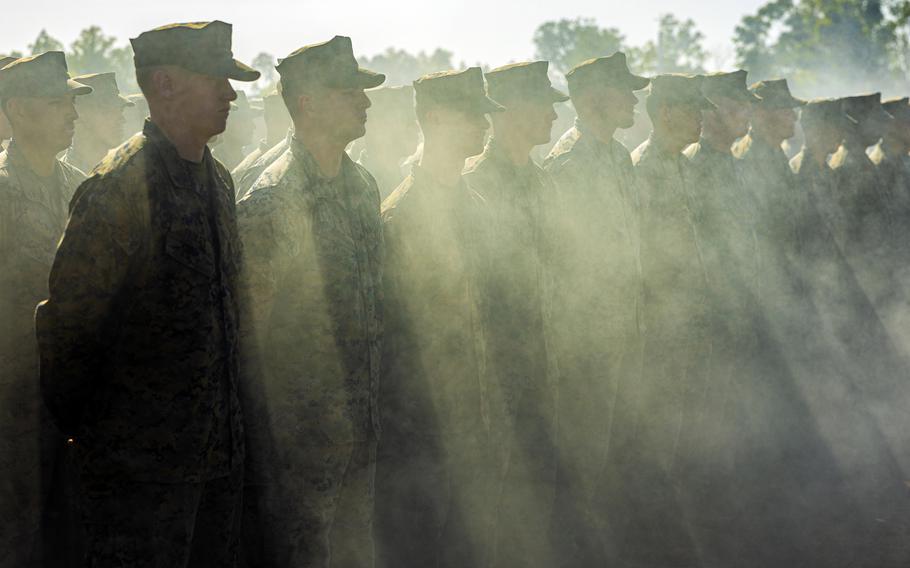
Marines stand at attention during the opening ceremony for Predator’s Run at Robertson Barracks in Australia's Northern Territory, July 15, 2024. (Cristian Bestul/U.S. Marine Corps)
The Marine Corps kicked off a 25-day littoral combat exercise this week with thousands of troops from three allied nations in Australia’s Northern Territory.
Predator’s Run, which began Monday and concludes Aug. 8, includes troops from Australia, the Philippines, and the United Kingdom, Marine Rotational Force-Darwin said in a news release Tuesday.
Littoral combat encompasses operations in or near coastal areas.
Four thousand troops, including 1,400 Marines are involved in the drills, 1st Lt. Colton Martin, a spokesman for the rotational force, told Stars and Stripes by email Wednesday.
The Marines’ Force Design initiative adopted littoral combat as an approach to possible conflict with China in the Indo-Pacific. Since 2022, the Corps has created two littoral regiments on Hawaii and Okinawa, with a third coming to Guam.
The new doctrine calls on Marines to disperse across small islands in the region and attack enemy forces with anti-ship missiles.
There are a variety of reasons Predator’s Run is taking place in Australia, rather than on Southeast Asia islands where battles could be fought, according to Ross Babbage, a former Australian assistant defense secretary.
“There are many operational elements and systems needing refinement to conduct complex littoral operations well,” he said by email Wednesday. “It is best to sort those things and conduct much of the necessary training in safe and well understood areas possessing advanced instrumented ranges and other excellent facilities.”
It is also generally less expensive to train in Australia’s vast spaces, he added.
Members of the 2,000-strong rotational force, which arrived in Australia in March, are at Mount Bundey Training Area, south of Darwin, to kick off the exercise, according to the release.
However, the drills, led by the Australian army’s Darwin-based 1st Brigade, will take place across the Northern Territory and on Melville Island, in the eastern Timor Sea.
The exercise will employ as much of the rotational force as possible, showcasing expeditionary capabilities and innovative tactics. The force has been reinforced for the drill by the 1st Light Armored Reconnaissance Battalion deployed from Camp Pendleton, Calif., according to the release.
Participating units include 2nd Battalion, 5th Marine Regiment, Combat Logistics Battalion 5 and Marine Medium Tiltrotor Squadron 268.
“This training is essential to test and refine our ability to execute and integrate battle drills at each echelon, focusing on offense, defense, and counterattack,” 2nd Battalion commander Lt. Col. Clinton Hall said in the release.
“By applying simplicity to complex operations and focusing on combined arms in support of maneuver, we strengthen our mutual capabilities with our allies.”
Marines will conduct day and night operations and air assault drills aboard MV-22B Ospreys. All tiltrotors in the U.S. military returned to service in March after a three-month standdown. Flights temporarily ceased during the investigation into a fatal crash of an Air Force Osprey in November in southern Japan.
“This exercise will test our flexibility and adaptability in a complex but controlled environment to execute the core mission of a [tiltrotor] squadron in a medium threat environment while based out of an expeditionary site,” Lt. Col. Brandon Pope, the squadron’s commander, said in the release.
“Our ability to provide assault support to the [Marine Air Ground Task Force] and the joint force relies on our capacity to integrate in all phases of an operation,” he said.